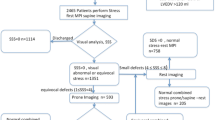Abstract
Background
The purpose of this study was to compare stress supine single photon emission computed tomography (SPECT) imaging with attenuation correction (AC) via computed tomography-based attenuation maps with stress prone SPECT imaging with regard to the rate of equivocal interpretation of rest/stress myocardial perfusion imaging.
Methods and Results
Interpretations for 324 consecutive patients referred for rest/stress myocardial perfusion imaging were performed by use of the following sets of poststress SPECT images: supine with no AC (NC), supine NC/AC, supine NC/prone, and all images. The number of equivocal studies decreased with additional imaging: supine NC, 40%; supine NC/prone, 18%; supine NC/AC, 11%; and all images, 8%. The supine NC/AC sets of images reduced the number of defects to a greater extent than the supine NC/prone images for all patients (P=.01), men (P=.002), and women (P=.425). For the inferior (but not the anterior) wall, the percent decrease in defects with supine NC/AC images was lower as compared with supine NC/prone images.
Conclusion
Interpretation with all images resulted in the fewest equivocal studies. The supine NC/AC images reduced the number of equivocal studies to a greater extent than the supine NC/prone images. AC and prone imaging were more helpful in men than women and were more helpful to resolve inferior than anterior wall defects. Adding prone imaging to supine imaging without and with AC does not significantly alter the number of equivocal interpretations.
Similar content being viewed by others
References
Klocke FJ, Baird MG, Lorell BH, et al. ACC/AHA/ASNC guidelines for the clinical use of cardiac radionuclide imaging-executive summary: a report of the American College of Cardiology/American Heart Association task force on practice guidelines (ACC/AHA/ASNC committee to revise the 1995 guidelines for the clinical use of cardiac radionuclide imagining. J Am Coll Cardiol 2003;42:1318–33.
Pitman AG, Kalff V, Van Every B, Risa B, Barnden LR, Kelley MJ. Contributions of subdiaphragmatic activity, attenuation, and diaphragmatic motion to inferior wall artifact in attenuation-corrected Tc-99m myocardial perfusion SPECT. J Nucl Cardiol 2005;12:401–19.
Corbett JR, Kritzman JN, Ficaro EP. Attenuation correction for single photon emission computed tomography myocardial perfusion imaging. Curr Cardiol Rep 2004;6:32–40.
Hayes SW, Lorenzo AD, Hachamovitch R, et al. Prognostic implication of combined prone and supine acquisitions in patients with equivocal or abnormal supine myocardial perfusion SPECT. J Nucl Med 2003;44:1633–40.
Nishina H, Slomka P, Abidov A, et al. Combined supine and prone quantitative myocardial perfusion SPECT: method development and clinical validation in patients with no known coronary artery disease. J Nucl Med 2006;47:51–8.
Huntsinger R, Martin WH, Churchwell K, Delbeke D. Value of prone myocardial perfusion SPECT imaging (MPI) for patients with chest pain in the emergency department (ED) [abstract]. J Nucl Cardiol 2002;9:S17.
Bateman TM, Cullom SJ. Attenuation correction single photon emission computed tomography myocardial perfusion imaging. Semin Nucl Med 2005;35:37–51.
Hendel RC, Corbett JR, Cullom SJ, et al. The value and practice of attenuation correction for myocardial perfusion SPECT imaging: a joint position statement from the American Society of Nuclear Cardiology and the Society of Nuclear Medicine. J Nucl Med 2002;43:273–80.
Patton JA, Delbeke D, Sandler MP. Image fusion using an integrated dual-head coincidence camera with x-ray tube based attenuation maps. J Nucl Med 2000;41:1364–8.
Masood Y, Liu HY, Depuey G, et al. Clinical validation of SPECT attenuation correction using x-ray computed tomography-derived attenuation maps: multicenter clinical trial with angiographic correlation. J Nucl Cardiol 2005;12:676–86.
American Society of Nuclear Cardiology. Updated imaging guidelines for nuclear cardiology procedures, part 1. J Nucl Cardiol 2001;8:G5–58.
Cerqueira MD, Weissman NJ, Dilsizian V, Jacobs AK, Kaul S, Laskey WK, et al. American Heart Association Writing Group on Myocardial Segmentation and Registration for Cardiac Imaging Standardized myocardial segmentation and nomenclature for tomographic imaging of the heart: a statement for healthcare professionals from the Cardiac Imaging Committee of the Council on Clinical Cardiology of the American Heart Association. J Nucl Cardiol 2002;9:240–5.
Mansoor MR, Heller GV. Gated SPECT imaging. Semin Nucl Med 1999;29:271–8.
Berman DS, Kiat H, Friedman JD, Wang FP, van Train K, Matzer L, et al. Separate acquisition rest thallium-201/stress technetium-99m sestamibi dual-isotope myocardial perfusion single-photon emission computed tomography: a clinical validation study. J Am Coll Cardiol 1993;22:1455–64.
Berman DS, Abidov A, Kang X, Hayes SW, Friedman JD, Sciammarella MG, et al. Prognostic validation of a 17-segment score derived from a 20-segment score for myocardial perfusion SPECT interpretation. J Nucl Cardiol 2004;11:414–23.
Author information
Authors and Affiliations
Corresponding author
Rights and permissions
About this article
Cite this article
Malkerneker, D., Brenner, R., Martin, W.H. et al. CT-based attenuation correction versus prone imaging to decrease equivocal interpretations of rest/stress Tc-99m tetrofosmin SPECT MPI. J Nucl Cardiol 14, 314–323 (2007). https://doi.org/10.1016/j.nuclcard.2007.02.005
Issue Date:
DOI: https://doi.org/10.1016/j.nuclcard.2007.02.005




